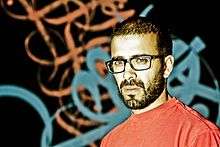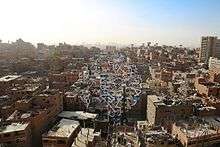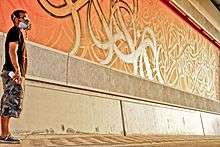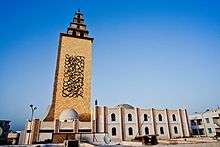eL Seed
eL Seed (born 1981) is a French-Tunisian street artist whose works incorporate traditional Arabic calligraphy, a style he calls calligraffiti.[1] Since the 2011 Tunisian revolution, eL Seed has consciously used his art as a tool of political expression, much like Egypt's Mohamed Mahmoud graffiti. He cites the Palestinian poet Mahmoud Darwish and the Iraqi artist Sundus Abdul-Hadi as inspirational figures whose art was able to spark political change.[2]
eL Seed | |
|---|---|
 | |
| Born | 21 August 1981 (age 38) Le Chesnay, Île-de-France, France |
| Nationality | French-Tunisian |
| Known for | Art Installation, Sculpture |
Notable work | Perception in cairo |
| Movement | Hurufiyya movement |
| Website | elseed-art |
Early life and career
Born to a Tunisian family in Paris, France in 1981, eL Seed grew up speaking only the Tunisian dialect, and did not learn to read or write standard Arabic until his teens, when discovered a renewed interest in his Tunisian roots.[4]
As a street artist, he took the name "elSeed" from the French play, El Cid, which his teacher was reading to his class in school. The name, El Cid, in turn, is based on the Arabic term, Al Sayed, which means "the man."[5] He cites the 2011 Tunisian Revolution as a major factor in the opening of political space to alternate forms of expression. "The revolution pushed people to be more creative because before they were scared – and now they have more freedom."[4]
He created his first large-scale mural one year after the beginning of the Tunisian revolution, in the city of Kairouan. This mural was a calligraphic representation of passage from a Tunisian poem by Abu al-Qasim al-Husayfi dedicated to those struggling against tyranny and injustice.[4] His influences include other graffiti artists including; Hest 1 and Shuck 2 along with Arabic calligraphers such as Mahmood Darwish and Nizar Qabbani.[6]
In an interview with the media, he explained his desire to make political statements:[7]
- "I always make sure that I am writing messages, but there are also layers of political and social context and that's what I am trying to add into my work. The aesthetic is really important, that's what captures your attention, but then I try to open a dialogue that's based on the location and my choice of text."
His most controversial project was the 2012 painting of a minaret of the Jara Mosque in the southern Tunisian city of Gabes.[8] About the project, el Seed explained, "my goal was to bring people together, which is why I chose these words from the Quran. I like graffiti because it brings art to everyone. I like the fact of democratizing art. I hope it will inspire other people to do crazy projects and not to be scared".[4]
eL Seed's art has been shown in exhibitions in Berlin, Chicago, Dubai, Paris, and São Paulo, and he has also painted murals on the walls of various cities including Melbourne, London, and Toronto, in addition to various Tunisian cities.
Perception, Cairo, Egypt
In his latest project ‘Perception’ eL Seed is questioning the level of judgment and misconception society can unconsciously have upon a community based on their differences.[9] In the neighborhood of Manshiyat Nasr in Cairo, the Coptic community of Zaraeeb collects the trash of the city for decades and developed the most efficient and highly profitable recycling system on a global level. Still, the place is perceived as dirty, marginalized and segregated. To bring light on this community, with his team and the help of the local community, eL Seed created an anamorphic piece that covers almost 50 buildings only visible from a certain point of the Muqattam Mountain. The piece of art uses the words of Saint Athanasius of Alexandria, a Coptic Bishop from the 3rd century, that said: ‘Anyone who wants to see the sunlight clearly needs to wipe his eye first.'
- "The Zaraeeb community welcomed my team and me as if we were family. It was one of the most amazing human experiences I have ever had. They are generous, honest and strong people. They have been given the name of Zabaleen (the garbage people), but this is not how they call themselves. They don't live in the garbage but from the garbage; and it is not their garbage, but the garbage of the whole city. They are the ones who clean the city of Cairo."
Salwa Road, Doha, Qatar
In early 2013, eL Seed was commissioned by the Qatar Museums Authority to create a series of 52 artworks in Doha's Salwa Road area.
Art on Jara Mosque, Gabes, Tunisia
Reacting to the clashes between religious sects and the art community in Tunisia, the artist embarked on a project to transform this religious landmark into a public artwork during the holy month of Ramadan. eL Seed's large-scale production cites traditional principles of Arabic script with a modern sensibilities.
Recent tensions in Tunisia have sparked a critical debate about the limits of artistic freedoms in the birthplace of the Arab Spring as it undergoes a nascent transition to democracy. "This project is not about decorating a mosque, it is about making art a visible actor in the process of cultural and political change," comments el Seed, who started work on the mural on 20 July. "I truly believe that art can bring about fruitful debate, especially within the uncertain political climate right now in Tunisia."
The project was approved by the Governor of Gabès and the mosque's imam, Shaikh Slah Nacef. The 57-metre-high (187-foot) mural will permanently cover the entire concrete tower face of Jara Mosque in hopes of highlighting the convergence of art and religion and raising the public's awareness by infusing art directly into the urban landscape. Exhibiting the words, "Oh humankind, we have created you from a male and a female and made people and tribes so you may know each other," eL Seed quoted a verse from the Quran which addresses the importance of mutual respect and tolerance through knowledge as an obligation.
"I hope that this artistic wall on the minaret will help to revive the city, and especially tourism in Gabes," commented Shaykh Slah Nacef.
Work
Exhibitions
- 2012 October 2012 – The Walls, solo exhibition – Itinerrance Gallery, Paris
- 2013 Solo exhibition – Medina, Tunis
- 2014 Declaration, sculpture exhibition – Tashkeel Gallery, Dubai
- 2016 Cairo – Arttalks.
Bibliography
- Lost Walls: a Calligraffiti Journey through Tunisia. From here to Fame, Berlin (2014)
Personal life
eL Seed is based in Dubai.
References
- Ro, Jihyun Ro (2 April 2012). "eL Seed Demonstrates Arabic Graffiti". The Harvard Crimson. Retrieved 6 June 2016.
- "El Seed on Graffiti, Censorship in Tunisia, And Why Arabic Is an Artist's Best Friend (Slideshow). HuffPost. 27 September 2012.
- Ben Cheikh, Mehdi (2015). Djerbahood : le musée de street art à ciel ouvert. Albin Michel.
- "Art on Jara Mosque" Archived 12 April 2013 at the Wayback Machine. CNN. 19 September 2012.
- Rubin, J., "El Seed: Lost Walls, St.Art Magazine, 27 March 2017, p. 8, Online:
- Wilson, J.A.J., "Five Minutes with eL Seed, Calligraffiti Artist," University of Greenwich, 2 July 2015, Online: Archived 13 November 2016 at the Wayback Machine
- Leech, N., "Hurufiyya: When Modern Art Meets Islamic Heritage," The National, 12 January 2017, Online: https://www.thenational.ae/arts-culture/hurufiyya-when-modern-art-meets-islamic-heritage-1.56505?videoId=5717340062001 Archived 11 May 2018 at the Wayback Machine
- Seaman, Anna (28 July 2018). "eL Seed: Building bridges with Arabic from Korea to Cape Town". Al Jazeera. Retrieved 30 August 2018.
- Fahim, couchieq (28 March 2016). "Sprawling Mural Pays Homage to Cairo's Garbage Collectors". The New York Times. ISSN 0362-4331. Archived from the original on 16 April 2016. Retrieved 15 April 2016.
Further reading
- Pascal Zoghbi, Arabic Graffiti curated and authored by Lebanese typographer, publisher Stone aka Don Karl, released 15 April 2011.
- Rose Issa, Juliet Cestar and Venetia Porter, Signs of Our Times: From Calligraphy to Calligraffiti, New York, Merrill, 2016
External links
- Madinati – Art on Jara Mosque, Gabes – eL Seed, DafoxinDabox and Kafi Films Video
- Salwa Road Project- Doha
- Ted Talk – Ted Fellows 2015, Art for hope and peace
- Ted Talk – Ted Summit 2016, A project of peace.
- eL Seed Profil by CNN.
- EL Seed at TED



